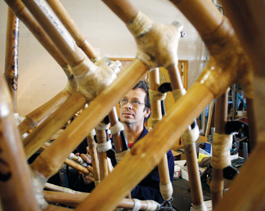home | metro santa cruz index | news | santa cruz | news article

Photograph by Curtis Cartier
RIGHT-AID: In keeping with his trade-not-aid theory of philanthropy, Craig Calfee has started a bamboo-bike-building concern in Ghana.
Bamboosted
Can poor countries ride bamboo bikes to prosperity? Craig Calfee thinks so.
By Curtis Cartier
IBRAHIM Nyampong is a 32-year-old entrepreneur who lives in Accra, the capital city of Ghana on Africa's west coast, where the average annual per capita income is $600. About two years ago, nationally renowned bicycle designer and Santa Cruz County native Craig Calfee taught him how to build bicycle frames from locally grown bamboo. Today, Nyampong earns about $150 for every frame he builds, shipping the completed frames—some a milky caramel color, others a deep mocha—to Calfee's La Selva Beach manufacturing shop, where the wiry bike designer and his team slap wheels and hardware on them, burn the name "Bamboosero" into the wood, then sell them to distributors, where they eventually fetch about $950 apiece. The operation makes Nyampong and his two employees wealthy by Ghanaian standards. It also supports Calfee's basic mantra that when it comes to helping people in developing countries, "Trade is better than aid."
"I'd been going to Africa for years since the early '80s, and what people really want and need over there is jobs, it's not handouts," says Calfee as he adjusts the front fork on what will be a special "art bike" made from bamboo and steer horns. "So basically I went and trained Ibrahim to make the bikes. Now he's got a little shop and a couple employees and an apprentice, and he does really well. The idea then would be that he can train other people to do this, and hopefully it will catch on."
Most people know Calfee Design bicycles not for their bamboo line but for their ultra-high-end carbon fiber bikes, which can go for more than $8,000 and are ridden by folks like three-time Tour de France winner Greg LeMond. Bamboo is the fastest-growing plant on earth, and, Calfee says, is like the carbon fiber of the natural world—strong, light and durable. Unlike synthetic and expensive carbon fiber, however, bamboo is cheap, easy to grow and needs no welding torches or expensive machines to turn into a bike frame.
For Nyampong, Bamboosero represents an opportunity that few Africans get and one he thinks will only get better as time goes on.
"Everybody likes the bikes in Accra," writes Nyampong in an email to Santa Cruz Weekly. "They all think that Bamboosero is going to be big in the near future and Accra is going to be the biggest distributor for bamboo bikes in the whole world."
Dog Chewed and Bambooed
Calfee's Bamboosero project in Ghana is only 2 years old, but the idea to build a bicycle from bamboo came about nearly 15 years ago with the help of a scrap piece of wood and a certain Labrador mix named Luna.
"My dog Luna loved to play this game with a stick where she would tug on the stick and you would tug back and you could swing her around off the ground with this stick in her teeth," says Calfee. "Well, she had found this piece of bamboo and wanted to play the game with me, and I kept thinking, 'This is gonna break.' But it never broke, even with this 60-pound dog being flung around, and I thought, 'Man, you could make a good bike out of this stuff.'"
The bikes themselves range from the slightly rough-cut African line, which are made with inexpensive Chinese hardware and prized for their affordability, to the higher end models, which use smoked bamboo from Taiwan and receive some of the same hardware and exacting specifications as Calfee's professional carbon fiber variety. All come in mountain, road, cargo and tandem designs, and Calfee even has a special "school bus bike" that a sturdy driver can use to schlep up to six kids to school with—one solution to what Calfee says is a huge problem of poor school attendance in Africa.
One particular bicycle Calfee hopes will catch on in a big way is the cargo bike. Stretched long and with an extended rear integrated rack and a bamboo reinforced rear wheel, it's capable of hauling up to 420 pounds on its back end, a fact partially demonstrated by Calfee's using 165 pounds' worth of white-knuckled reporter clinging on the rear. The Bamboosero mountain bike was also given a test run and proved light, maneuverable and exceptionally smooth.
As of December, Calfee has sold 28 Bamboosero bikes and sent six back to Ghana, where they're ridden by locals and tourists. Calfee, in true bicycle salesman form, says that the best way to get more people building and riding bamboo bikes in Africa is to buy a Bamboosero bike in America.
"Whatever happens, we want them to build bikes and send them here while we build up the credibility for the concept," says Calfee. "It's all about giving them a real business opportunity—something they can get behind and take pride in."
For more pictures of the Bamboosero bike visit www.santacruz.com/news.
Send a letter to the editor about this story.
|
|
|
|
|
|